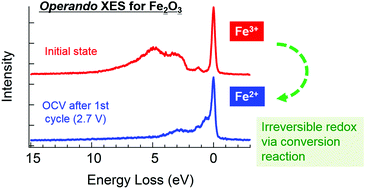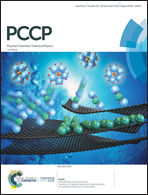Operando soft X-ray emission spectroscopy of the Fe2O3 anode to observe the conversion reaction†
Abstract
Drastic electronic-structure changes in an Fe2O3 thin film anode for a Li-ion battery during discharge (lithiation) and charge (delithiation) processes were observed using operando Fe 2p soft X-ray emission spectroscopy (XES). The conversion reaction forming metallic iron due to the lithiation reaction was confirmed by operando XES in combination with the analysis using full-multiplet calculation. The valence of Fe at the open-circuit voltage (OCV) before the second cycle was not Fe3+, but Fe2+ with a weak p–d hybridization, suggesting a considerable irreversibility upon the first discharge–charge cycle and a weakened Fe–O bond after the first cycle. Moreover, we revealed that the Fe 3d electronic-structure change during the second cycle was to some extent reversible as Fe2+ (2.7 V vs. Li/Li+: open circuit voltage) → Fe0 (0.1 V vs. Li/Li+: discharged) → Fe(2+δ)+ (3.0 V vs. Li/Li+: charged). This operando Fe 2p XES in combination with the full-multiplet calculation provides detailed information for redox chemistry during a discharge–charge operation that cannot be obtained by other methods such as crystal-structure and morphology analyses. XES is thus very powerful for investigating the origin and limitation of the lithiation function of anodes involving conversion reactions.

- This article is part of the themed collection: 2019 PCCP HOT Articles


 Please wait while we load your content...
Please wait while we load your content...